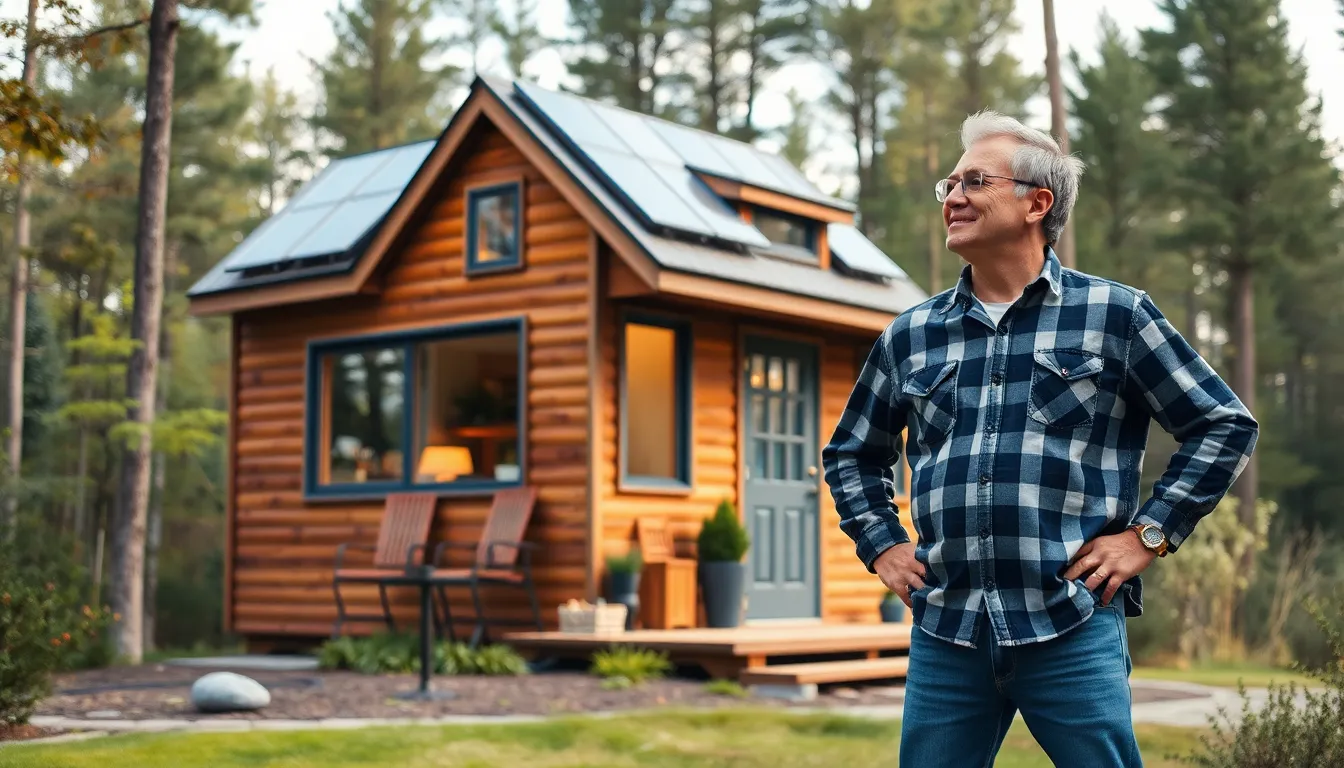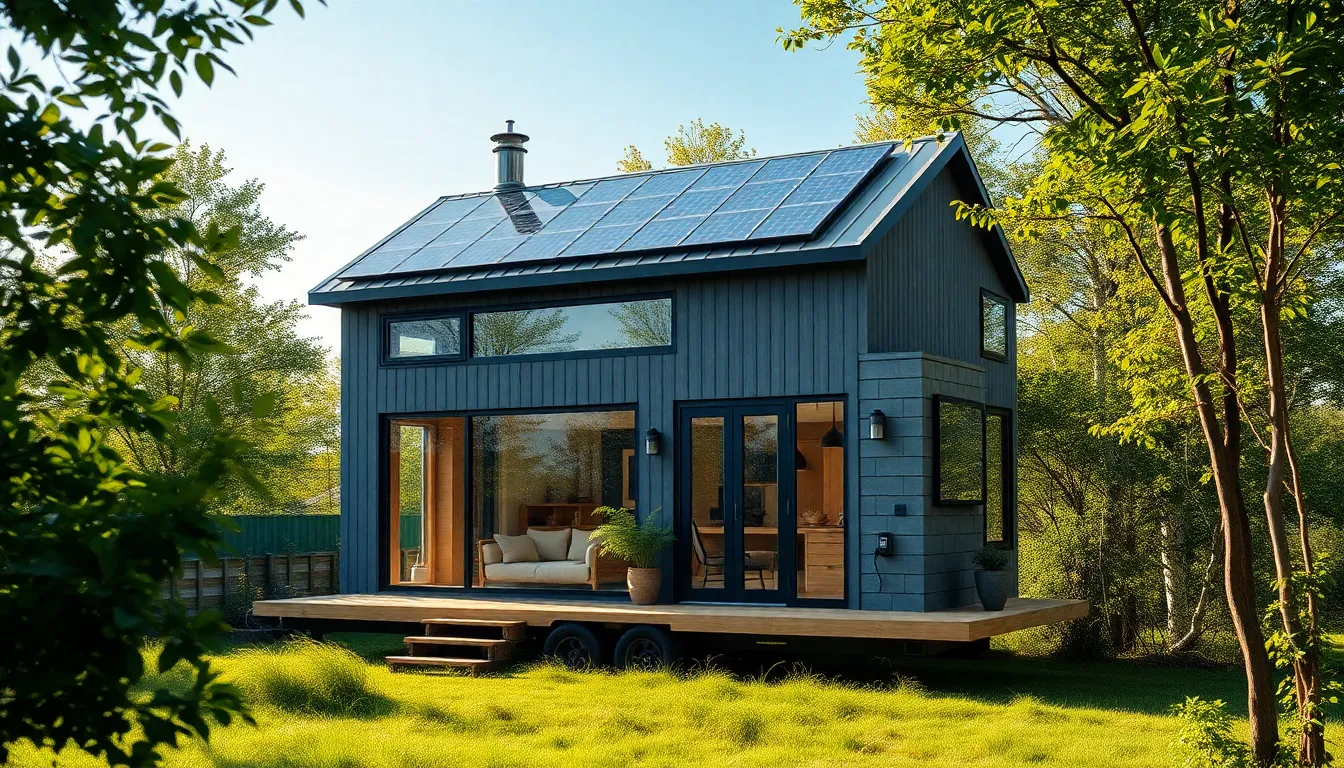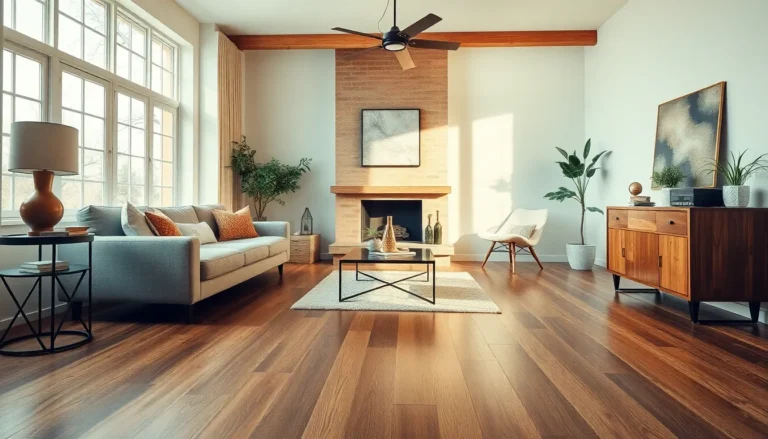Table of Contents
ToggleTiny houses are all the rage, and for good reason. Imagine living in a space that’s not just cozy but also kind to the planet. An energy-efficient tiny house is like the superhero of the housing world, saving the environment one square foot at a time. Who wouldn’t want to reduce their carbon footprint while sipping coffee in a stylish, compact abode?
Overview of Energy-Efficient Tiny Houses
Energy-efficient tiny houses merge compact living with sustainable practices. These homes routinely utilize advanced insulation materials that retain heat and reduce energy consumption. Incorporating solar panels often leads to significant energy savings, allowing homeowners to harness renewable energy.
Many designs focus on maximizing natural light, reducing the need for artificial lighting. Proper ventilation systems enhance indoor air quality while minimizing reliance on heating and cooling systems. Rainwater harvesting systems efficiently collect and store water for various household uses, promoting sustainable living.
Energy-efficient appliances play a crucial role in minimizing energy usage. Energy Star-rated devices provide high performance without excessive energy consumption. Moreover, smart home technology allows homeowners to monitor and control energy use effectively, maximizing efficiency.
Living in a tiny house often reduces the overall ecological footprint, contributing to environmental sustainability. Small space living encourages mindful consumption, leading to lower utility bills and maintenance costs. Interest in these homes continues to grow, as people seek affordable, eco-conscious alternatives to traditional housing.
Tiny houses exemplify the commitment to sustainability while offering cozy, stylish living spaces. Features like composting toilets and recycled materials reinforce the ecological benefits of these homes. Overall, energy-efficient tiny houses represent a lifestyle choice prioritizing environmental impact and economic practicality.
Benefits of Energy-Efficient Tiny Houses
Energy-efficient tiny houses offer numerous advantages, especially in promoting sustainable living. These homes significantly reduce environmental impact while enhancing the overall living experience.
Environmental Impact
Energy-efficient tiny houses use sustainable materials and advanced designs to minimize energy consumption. Utilizing solar panels generates renewable energy, decreasing reliance on non-renewable resources. Proper insulation prevents heat loss, leading to lower energy usage for heating and cooling. Natural light is maximized through strategic window placements, reducing dependence on artificial lighting. Incorporating rainwater harvesting systems supports water conservation efforts. These homes ultimately contribute to a smaller carbon footprint, making a notable positive impact on the planet.
Cost Savings
Cost savings represent another compelling benefit of energy-efficient tiny houses. Smaller square footage leads to lower utility bills, with many homeowners reporting savings of up to 50%. Energy-efficient appliances consume less power, further reducing costs over time. Maintenance expenses decrease as energy-efficient features enhance durability. Avoiding traditional home costs such as extensive landscaping and high property taxes contributes to financial freedom. This economic advantage allows for reinvestment in other sustainable practices or experiences that enrich life.
Design Considerations for Energy Efficiency
Creating an energy-efficient tiny house involves thoughtful design choices. Prioritizing materials and energy sources leads to significant benefits in sustainability.
Insulation and Materials
Effective insulation plays a crucial role in energy efficiency. Choosing high-quality insulation materials, such as spray foam or cellulose, enhances thermal performance. These materials minimize heat loss in winter and keep homes cool in summer. Utilizing recycled, sustainable materials for construction further supports eco-friendly living. Additionally, triple-glazed windows not only insulate but also allow for natural light, reducing the need for artificial lighting. Selecting durable materials leads to longevity, resulting in fewer replacements. Prioritizing these elements contributes to a smaller ecological footprint.
Sustainable Energy Sources
Incorporating sustainable energy sources provides reliable power with minimal environmental impact. Solar panels generate clean energy, often covering a significant portion of electricity needs for tiny homes. Wind turbines can serve as supplemental energy sources in suitable locations. Connecting to the grid offers flexibility, allowing homeowners to draw or contribute energy as needed. Rainwater harvesting systems reduce reliance on municipal water supply, promoting conservation. Energy-efficient appliances further decrease electricity consumption, making the overall energy strategy more effective. Choosing these sources emphasizes a commitment to sustainability in tiny home living.
Popular Energy-Efficient Tiny House Models
Several energy-efficient tiny house models stand out for their innovative designs and eco-friendly features.
- Tumbleweed Tiny House Company: This company offers a variety of stylish models, including the Cypress, renowned for its energy-efficient construction. With options for solar panel installations and high-quality insulation, homeowners achieve significant utility savings.
- Breathe Architecture’s Eco Tiny House: Located in Australia, this model utilizes cross-ventilation strategies and natural materials for energy efficiency. Its green design reduces carbon emissions while providing a comfortable living environment.
- Tiny Mountain Houses: The Cedar model combines rustic aesthetics with modern efficiency. Energy-saving appliances and a rainwater collection system are standard features that contribute to lower household expenses.
- Ecospace: This model emphasizes sustainability with its prefabricated design and smart home technology. Solar energy systems and green roofs enhance its energy independence and reduce reliance on traditional utilities.
- Tiny House Basics: Their models, such as the Sprout, focus on efficient layout and insulation. Customization options include energy-efficient windows that minimize heat loss and natural light exposure, which combined improve energy use.
- Zillow’s Tiny House Collection: A platform showcasing various models from manufacturers nationwide allows potential homeowners to explore energy-efficient options. Features like sustainable materials and compact layouts enhance livability while supporting eco-friendly practices.
These models reflect the commitment to sustainability evident in the tiny house movement. Each option offers unique benefits, supporting both environmental responsibility and viable financial strategies for homeowners. Embracing energy efficiency leads to reduced monthly expenses and promotes a minimalistic lifestyle that many seek today.
Challenges of Living in an Energy-Efficient Tiny House
Living in an energy-efficient tiny house presents unique challenges that potential homeowners must consider. Space constraints often lead to limited storage options, requiring thoughtful organization to maintain a clutter-free environment. Compact layouts might restrict the number of appliances and furniture, leaving residents to prioritize essential items.
Energy management becomes crucial in tiny homes. Though these houses typically feature energy-efficient designs, the smaller size may translate to higher indoor temperatures during summer months. Residents may need to invest in effective ventilation systems to ensure comfort without compromising energy savings.
Water conservation can pose challenges as well. Rainwater harvesting systems require regular maintenance to function optimally. Additionally, homeowners must understand local regulations regarding water collection to avoid legal issues.
Adapting to a minimalist lifestyle can be difficult for some individuals. Downsizing possessions often involves emotional attachments to belongings, which can complicate the transition. A simpler lifestyle encourages mindfulness but can be challenging to embrace fully.
Even with advancements in technology, reliance on renewable energy sources, like solar panels, may introduce uncertainties. Energy generation can fluctuate based on weather conditions, impacting daily life. Understanding energy consumption and storage becomes essential for maintaining a stable power supply.
Affordability also presents a challenge, particularly during the construction phase. Upfront costs for sustainable materials and energy-efficient appliances may exceed traditional building methods. Homeowners often need to balance initial investments with long-term savings when planning their finances.
Overall, the journey of living in an energy-efficient tiny house demands careful consideration, thoughtful planning, and a willingness to adapt. Each aspect requires attention to detail and a commitment to sustainability while addressing the inherent constraints of tiny living.
Conclusion
Energy-efficient tiny houses represent a significant shift towards sustainable living. They combine innovative design with eco-friendly practices to create homes that are not only stylish but also minimize environmental impact. By embracing these compact spaces, homeowners can enjoy lower utility bills and reduced maintenance costs while contributing to a healthier planet.
The commitment to sustainability in tiny house living is evident through the use of advanced materials and technologies. As more people seek to simplify their lives and reduce their carbon footprints, energy-efficient tiny houses stand out as a practical solution. This lifestyle not only fosters financial freedom but also encourages a more mindful approach to consumption and resource management. Embracing energy efficiency in tiny living is a step towards a more sustainable future.








